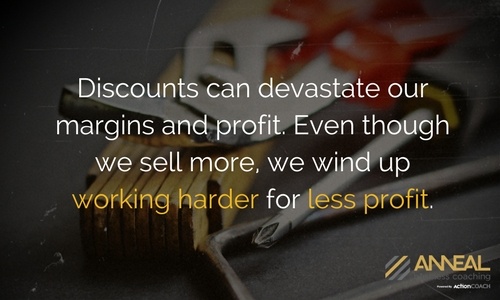4 MIN READ
You can’t be a business coach for long without stumbling onto a universal truth: Business owners want more sales. Some, thankfully, have refined their thinking to a desire for more sales, but only for those that bring higher margins and higher profit. After all, profit, not sales, is the goal.
"After all, profit, not sales, is the goal."
In our pursuit of more sales, most (all?) of us have resorted to negotiating on price - discounts. Many of us still do. We do it, of course, in the belief that customers will close more deals if we’re “flexible” on price.
That may be true, but it is also true that discounts can devastate our margins and profit, and, even though we sell more, we wind up working harder for less profit.
The first defense in price negotiations is a Unique Selling Proposition. When we understand our customers better than our competitors do, we can differentiate ourselves by giving them reasons other than price to buy from us.
“Okay,” you say, “I’m working on my USP and I understand the dangers of discounting. I get it. No negotiations on price. But c’mon, there are still times I have to sweeten the offer to close a deal. How can I do that without wrecking margins?”
Beyond an effective USP, here are two approaches to preserving margins in price negotiations:
Offer the customer more for the same, rather than the same for less, and
Capitalize on high perceived value
At first blush, giving customers more for the same price may seem like a discount in disguise, and it may be.
The discount is disguised in the cost of the product we add to our offer. However, more-for-the-same presents an opportunity to improve on discounting by preserving margins on the “same” part of the transaction, even if there is a price concession on the “more” part.”
Confused? Let’s look at an example.

Suppose we bid a project for $10,000 that will cost us $6,000 to complete. Sell it at full price and we will earn a $4,000 margin.
Now suppose our customer comes down hard on us. He tells us that our competitor is better-looking and just as good but cheaper. He even shows us the other guy’s written bid. He says he’ll sign with us, but only if we knock 10% off the price. Our $10,000 sale would drop to $9,000, and our margin would drop by 25% to $3,000.
Ouch!
Now suppose we counter by offering him a free feature “valued” at $1,000. We’ve preserved our original bid and our discount on the project will be the cost of the free feature.
That’s where the idea of high perceived value comes in.
Perceived value is the customer’s perception of the value of a product or service. It may or may not be related to our cost. Some perceived values are pretty obvious.
For example, if we knock that $1,000 off the price of the project, both our concession and the customer’s perception of it will be $1,000. In contrast, if we give the customer an add-on “valued” at $1,000, his perception of our concession will be $1,000, regardless of our cost. Do you see the opportunity here?
"Do you see the opportunity here?"
The “value” of the add-on can be anything we say it is. If our cost is low, the damage done to our margins will be also low.
Instead of conceding on price, let’s say we negotiate our original $10,000 bid price but to seal the deal, we throw in for free a $1,000 perceived value add-on that cost us $200, or 5% of our original margin.
That’s a big improvement over 25%!
Just because I used a free add-on in my example, doesn't mean we have to resort to “free.” We could offer our customer the $1,000 add-on at the special price of $500. The customer “saves” $500 and we make an extra $300 margin. Not bad.
There is another important advantage to the more-for-the-same offer. It doesn’t take long before a discounted price becomes “the” price in the eyes of customers.
Once it is seen as the “real” price, it won’t take long before customers begin negotiating for discounts on the new price.
The result is continuous downward spiral of prices and margins.
We can defend our margins by thinking in terms of:
How about you? Have you developed your USP? In tough negotiations, do you immediately default to price concessions? What offerings do you have with a high perceived value? What offerings could you develop into high perceived value, premium offers?